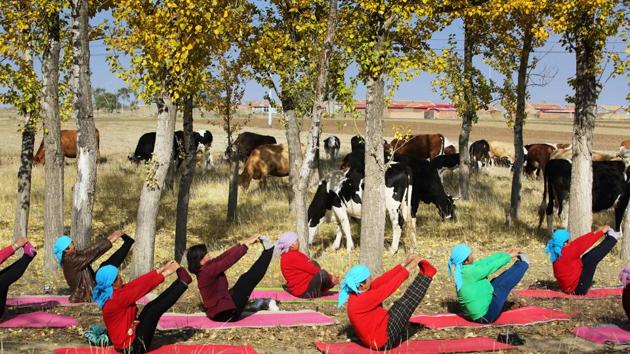How yoga helped people escape poverty in this Chinese village
Yoga Day 2019: Most of the 260-odd villagers of Yugouliang were poor until 2016, eking out a subsistence-level life through basic farming.
At a village some 300 km away from Beijing, elderly locals are not only using yoga to cure aches and pains but also to lift themselves out of poverty.

Until 2016, most of the 260-odd villagers of Yugouliang were poor, eking out a subsistence-level life through basic farming; their children had migrated to work in cities and could barely support them.
In three years since yoga was introduced, the economics of the village has changed, Lu Wenzhen, a government official who helped popularise the practice in the village as a way to alleviate poverty said.
“The average income of the poor in the village increased by about 1100 yuan last year. This does not include government subsidies. This is all brought about by yoga because of which many people now know Yugouliang. Its popularity is increasing, so the villagers can now sell higher-priced agricultural products, like quinoa, compared to other villages,” Lu told HT over email.
Also Read |‘Yoga belongs to everyone, everyone belongs to yoga’, says PM Modi at mega event in Ranchi
Lu added that quinoa is mostly purchased by yoga practitioners for its high nutrient content and is considered a super grain.
“When we first arrived, the number of poor people was 254, and then decreased to 137. Now there are 4 families, which are 6 people who have not been lifted out of poverty,” he said.
Lu wasn’t initially trained as a yoga teacher but subsequently took part in a “fitness yoga training course held by the General Administration of Sport of China”.
It’s not only the money, Lu said, adding that yoga has changed the quality of lives of the villagers.
“The villagers’ daily life is now (led) “yoga style”. Yoga has become a new life attitude and lifestyle among Yugouliang farmers,” he said.
“Yoga does benefit the villagers, especially the left-behind elderly (whose children have migrated). They are no longer lonely. Yoga has become their spiritual sustenance and pursuit of a new life. Their health level has been significantly improved and their mood is more cheerful. They have more confidence in life,” Lu said.
Lu used creative language to explain basic Yoga postures to the villagers.
“The Adho Mukha Svanasana is the posture when you keep still with your limbs crawling. At first, we called it ‘butt-flipping’ because the villagers could understand it. The locust pose, we call it flying, because the villagers feel more excited. Because my teaching objects are for left-behind elderly and peasants, I have to use language and methods which they can understand.”
Also Read | Yoga, one of PM Modi’s biggest achievements of cultural diplomacy, says Rajnath Singh
Lu said the villagers have never participated in the International Yoga Day, which falls June 21, but every year, collective yoga performances are held in the village during major events such as May Day, the Chinese National Day in October or the Chinese National Fitness Day, which falls on October 8.
Lu said Yoga could strengthen friendly exchanges between China and India draw the two people closer through yoga.
“Yoga will also be a common language for friendly exchanges between the two peoples,” Lu said.






